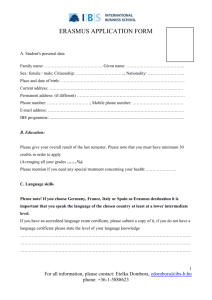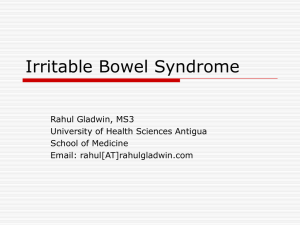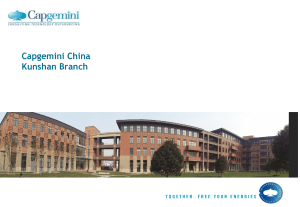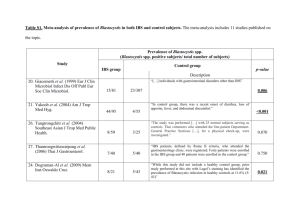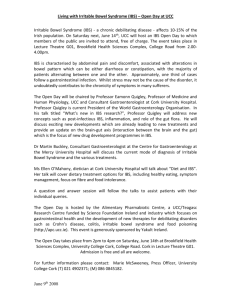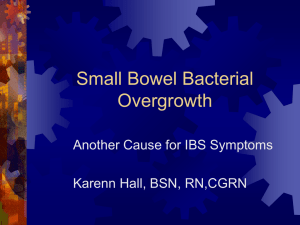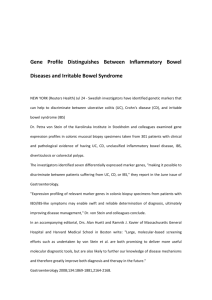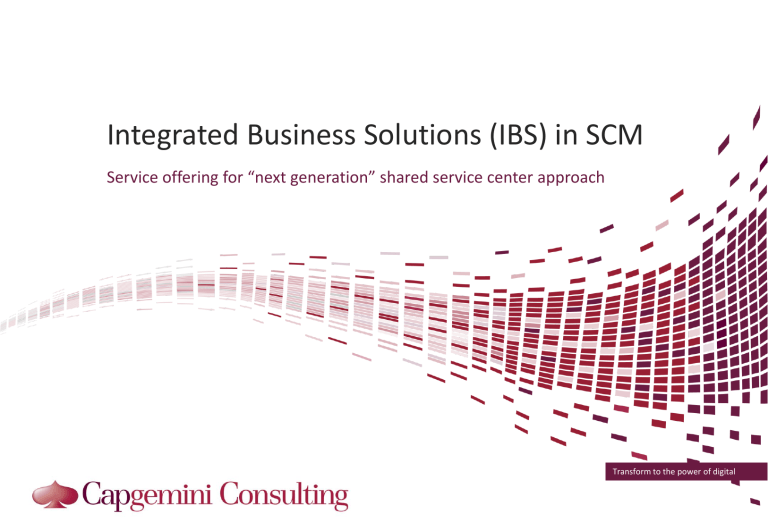
Integrated Business Solutions (IBS) in SCM
Service offering for “next generation” shared service center approach
Transform to the power of digital
In recent years, consolidation possibilities emerged with a global perspective where one
saw American companies as pioneers and European companies as followers of the trend
Development of Service Function Scope and Delivery Models
Development of Service Function Scope
Development of Delivery Models
2014
Operational services and support
Consolidation of operational business processes (e.g.
Documentation, master data management,...) and bundling
in either captive SSCs or selective BPO
Classic Support Functions
Outsourcing of IT services (IM / AM), BPO for
Accounting / Payroll, Captive SSCs for additional
support functions
Components
Reduction of vertical integration by
sourcing of components or assembly
groups
Industrialized services
Workforce optimization
Core competence
optimization
Global
balancing
Global and connected
world
Desire for much lower
labour costs
Offshore /
Rightshore
Availability of skilled
workforce
Capture and transport
knowledge
Nearshore
Demand locations
Demand restrictions
Onshore
1980
Having learned from classic shared service centers, the scope of consolidated service functions is now widened to
operational business, focusing on highly standardized transactional processes
Source: North Carolina State University, New York University, Capgemini Research
Copyright © 2014 Capgemini Consulting. All rights reserved.
2
IBS can be seen as a “next generation shared service center” approach with a widened up
positioning to create a service delivery unit for transactional parts of the supply chain
IBS positioning and purpose
Relation to operative business
Specific
Transactional
Value-add
Business area
Business area / operations specific tasks
with high local component
Mostly transactional, regular activities
Necessity for local input / programs
2
General
Transactional Partner / Shared Services
Rule based, high volume, operative focus
High process intensity
High standardization, effectiveness and
efficiency
1
Integrated
Business Solutions
Knowledge
based
Business Partner
Decision support for business
Linkage and alignment with business
necessary
High knowledge transfer
Support of decision and interface
between business areas and
operative processes
Corporate / Competence Center
Organized by knowledge areas
Cross BA leverage of high expertise
Development of internal “best practices”
Close link to top management
Periodical, non transactional
activities
3
Self Service
Business areas are enabled to independently work on tasks
Helpdesk & Callcenter
SPOC (Single point of contact) for internal contacts
The purpose of IBS is to shift
significant chains of the process
to a global supply chain
management backbone with
regional / global service delivery
centers by addressing four
levers:
1
Integrate / consolidate
2
Standardize
3
Digitize / automate
4
Manage services
global consolidation of
transactional processes
common process models /
transparent delivery
digital process interfaces and
automated workflows
application of service mgmt
(SLA/KPI/Pricing) standards
Copyright © 2014 Capgemini Consulting. All rights reserved.
3
Using a common operating model platform, nowadays service centers can be extended
towards the processes of supply chain management
SCM in the context of IBS
Supply Chain Management as new functional
scope for integrated business services,
leveraging existing centers and technology to
improve cost basis, drive standardization and
quality and allow for global scalability
Analytics
Controlling
Focus here
Supply Chain Mgmt
Plan
Develop
Source
14
Make
CREM/ Fac. Mgmt.
Store
Deliver
Return
IT
Common IBS Operating Model – global
support platform further increases cost savings
by harmonizing and standardizing IBS
structures
Procurement
HR
1
Vision and mission
Guiding principles
Governance framework
Strategy
2 Global delivery model
Delivery hub strategy
Delivery guidelines
Delivery locations /
site selection
Roll-in strategy and
planning
Finance
Business model
Value proposition
Roll-out strategy / concept
Organization and
3
governance
Vision
Mission
Global Business Services (GBS) will
– Reduce overall operating costs (costs/file)
– Operate standardized processes, ensure
process compliance & continuous
improvement
– Ensure and monitor high delivery quality
(share of first time right files)
– Increase flexibility and scalability of
core business
Organization,
governance and
escalation model
Framework policy
BCP1 concept
Global Business Services (GBS) is the
internal service provider for defined
services:
• Provides reliable cost efficient in-house,
services, monitored and reported by SLAs
& KPI’s
• Reflecting business needs (esp.
complexity, language, availability)
• Operates based on global standards,
while considering regional specifics
• Manages low staff turnover and
encourages employee development
Global
Business
Services
(GBS)
Manage
Ensure
Risk
Quality
Lever
Live
Wage
Arbitrage
Standardization
GBS
Vision
Increase
GBS is not:
• A separate profit center – it helps
business to increase local profits
• A global process owner – but supports
business to fulfill overall standards
Manage
Scalability
Drive
Complexity
CIP1
Performance and
4
service management
HR and workforce
5
qualification
KPI’s and service
governance
Pricing model
CIP2structure on
operational level
BSA and SLA’s3
Career model
Comp & Ben. concept
Workforce strategy
Role demand profiles
Recruiting strategy
Employee value
proposition
Trainings
Panalpina AG
Panalpina Executive Board
Group COO
Escalation
Level 4
GBS Governance Board
Internal Customers
GBS
GBS Reg. Gov. Board
Head of GBS
Regional BSC (1..n)
GBS
Conf irmed BSC locations
GBS
Possible f urther GBS centers
Area / Country
Mgmt.
BU Mgmt.
BSC Country Service
Management
Finance
Operations /
Product Manager
Operational
Interf aces
Escalation
Level 3
Processes /
GBS Services
Process Manager
Team Lead
Process Expert
Clerk
Panalpina GBS HR Strategy
Processes
• Translate strategic
targets into metrics
related to process
productivity and
quality
“Engaged people in the right job equipped with the right skills for today and tomorrow.”
HR Manager will be
responsible for the delivery of people related
elements of the company strategy in BSC and
acts as a Business Partner
to the BSC Mgr
Escalation
Level 2
Escalation
Level 1
Employees
• Translate strategic
targets into metrics
related to employees
Employees
Internal GBS
Customers
7
Possible scope for global service platform
Panalpina global defined
HR processes are
regionally adapted and
implemented on-site
HR core process within
the center is hire to
retire: recruitment,
placement, development,
training,
rewarding/retaining,
retirement
BSC HR managers are
disciplinary led by the BSC
manager and by
Panalpina Regional HR on
professional matters
Customers
• Translate strategic
targets into metrics
related to customers
3
HR roles
Operative
level
1 HR Governance
6
BSC HR Management focuses on qualitative HR tasks and cares about the BSC employees issues
Personnel administrative processes (e.g. payroll) are either outsourced or conducted by Region / Area*
Support regarding recruiting & qualification partially by external partner or Region / Area (during ramp-up)
2 HR Delivery Model
Dimensions for
GBS Performance
Management
GBS Regional
BSC Manager
BSC BU Service
Operations Management
Operations
GBS
Finance
• Translate strategic
targets into metrics
related to costs and
profitability
Global Business Services
RCEO
GBS
GBS
4
Processes & Policies
Communication
and change
Transition model
Stakeholder map
Communication and change Communication guideline
management plan
Employee talks
Products and
services
Service definitions
and principles
Resourcing
Service selection criteria
Service process split
Process service handbook
Typical SSC service scope today
0.Quot.
0.1
0.1.1
0.1.2
Check existing
internal customer
information
0.1.3
Check feasibility
and profitability
0.1.4
Finalize quotation
GBS / BSC culture shall
correspond to the global
Panalpina values and be
locally influenced to a
certain degree
People & Culture
There should be a
uniform global HR IT
system, preferably
Panlink (successfactors)
Preferable high degree of
digitalization of data and
administrative processes
(ESS/MSS)
6
IT System & Data
1. Export
1.1
Quotation
Receive quotation
request
Preferred recruiting
strategy: new employees
from local market
GBS will have its own
employer value
proposition
5
Regional Business Service Centers have their own (local) HR – BSC HR Manager
Each BSC HR Manager has a solid reporting line to the BSC management and a dotted line to Regional HR – he/she is involved in
the information flow of Country department to ensure regional integration and alignment with local HR topics
1.2
Order acceptance Export
1.1.1
Receive order from
customer or call
forward
1.1.2
Check feasibility
and profitability
1.1.3
Check internal
information
1.1.4
Initiate forwarding
order (“single file”)
1.1.5
Shipment planning
and booking (
1.2)
1.1.6
Pick-Up and Precarriage
( 1.3)
1.1.7
Additional services
( 1.4)
1.1.8
Complete
forwarding order
1.1.9
Confirm booking
1.1.10
Job costing
( 3.3)
1.3
Shipment
planning &
booking
1.2.1
Prepare and
initiate internal
booking
1.2.2
Place internal
booking
Pick-up &
pre-carriage
1.3.1
Initiate
subcontractor
order
1.3.2
Place
subcontractor
booking
1.4
1.5
Additional
services
1.4.1
Initiate service
order
1.4.2
Place service
booking
1.2.3
1.3.3
1.4.3
Create transit
forwarding order
Receive booking
confirmation
Receive service
subcontractor
booking
confirmation
1.2.4
Prepare & initiate
external booking &
potential
consolidation incl.
1.2.5FRB
Place external
booking
1.2.6
Receive
confirmation from
carrier
1.2.7
Send internal
booking
confirmation
1.6
Shipment processing
1.5.1
Customs clearance
export ( 1.6)
1.5.2
Security filing
1.5.3
House B/L
processing
1.5.9
Invoicing
( 1.8)
1.5.10
Complete
documentation
(incl. eFile)
1.7
Customs
clearance
export
Consolidation
1.7.1
Prepare
consolidation of
internal bookings
1.7.2
Finalize and
confirm load plan
1.8
Invoicing
1.8.1
Initiate and
prepare external
customer
invoice(s)
1.8.2
Initiate and
prepare internal
invoice(s)
1.8.3
Finalize and submit
invoice(s)
1.5.4
Consolidation
( 1.7)
1.5.5
Send carrier
shipment
instructions
1.5.6
Receive carrier
transport
documents
[O B/L; M B/L]
1.5.7
Third party
payment
( 3.9)
1.5.8
Update “Shipped
on Board” &
“Actual Time of
Sailing (ATS)”
Copyright © 2014 Capgemini Consulting. All rights reserved.
4
Along the entire supply chain we look at several processes, where consolidation brought
more than 20% of savings in costs or in FTEs
Overview of cost-saving potentials in supply chain processes1
14
15% reduction in FTE
through consolidating master
data management
5% deduction in
FTE through
offshoring Master
Data Management
10-15%
production
efficiency
66% reduction in
order cycle time
Plan
10-15 % cost savings in
technical
documentation costs
for complex products
15-25% reduction
in costs through
consolidation of
procurement
1
10% cost savings through
centralized container
management
5% cost reduction in
transport and logistics
through central
management
25% reduction of supply chain management
costs through offshoring the planning
14
Increase forecast accuracy 5-10%
Develop
Source
14
Make
Store
Deliver
Return
Up to 25% reduction
in costs through
consolidation of
procurement
Increase in category
spend compliance up to
95%
2-5% cost savings on inventory supplier
management and consignment
50% reduction of required warehouse
space
50% reduction in FTE
through central tariff
filing
20% reduction in FTE
through central
reporting
25% deduction in
FTE through central
export/ import
documentation
13% increase in product
availability through BPO
for inventory mgmt
Order lead time
improved by 12%
23% reduction of FTE for
order management
3-5% reduction in
inventory days
13% increase in product availability
through consolidation of
inventory management
Based on Capgemini Consulting project experience
Copyright © 2014 Capgemini Consulting. All rights reserved.
5
For a global freight forwarder we consolidated 20% of FTE in core logistics
processes in regional and global shared service centers on 4 continents
Plan
Develop
Source
Store
Deliver
Return
Case study consolidation of core processes in freight forwarding (1/2)
SITUATION & SOLUTION
1
4
Make
CASE STUDY
BENEFITS
Situation: Our client was facing heavy external and internal pressure
resulting in the decision to re-shape its operating model towards
consolidation and regionalization of transactional operational services
Consolidation of 20% of FTE’s in core processes
Savings of 50-60% personnel expenses per shifted FTE
10% p.a. steady state savings on OPEX
Process standardization and
harmonization for regional and global application
Established global service line organization, governance
model, performance / service management
Increased transparency through established KPI concept
Industrialized roll-out approach defined and applied to pilot
Cumulated
27.786 TEUR
in 2018
23.898
Year over Year Benefits
Total Cumulated
14.444
8.544
Top-line pressure
Bottom-line pressure
[TEUR]
-4190
-8.770
Permanent necessity to improve
cost basis and increase
productivity at equal or higher
quality
Market volatility
Continuously
high market
volatility,
currently
answered with
permanent
resource
adjustments
IBS strategy has to address
challenges on a long-term to ensure
future success and market
competiveness.
IBS is a strategic measures to
respond to these challenges
proactively and aspire industry
leadership.
Global customers
Transparency &
standardization
Manageability
and global
optimization
needs
transparency
and common
standards
Internal challenges
External challenges
Difficult logistics market and
economic environment - limited
growth options
CRITICAL SUCCESS FACTORS
Need for stability
Plan adherence and resource
stability is basis for reliant
operations and possible longlasting investments
Need for global service
availability at consistent high
quality in a globalized market
Solution: In close collaboration with client, establishment of a global
service unit comprising 4 regional Shared Service Centers on 4 continents
We supported our client in 3 phases of the transformation:
Strategy
development
-6.140
Concept
design
Center rampups and
global roll-ins
Early top management
involvement &
commitment
Rapid site selection and
ramp-up
IBS
Alignment of strategy and
delivery framework
IBS
Pilot implementation
IBS
Simulation combining
business and IT side
IBS
End-to-end process
analysis
Intense collaboration
Copyright © 2014 Capgemini Consulting. All rights reserved.
6
IBS for SCM follows the lifecycle for the set up of service centers – our approach covers
both transform and run phase with proven methods and deep SCM knowledge
IBS project approach
1 TRANSFORM
2 RUN
Analysis: Maturity
Assessment and Scenarios
Design: Integrated
Business Solutions
Build: Transformation
approach / management
Improve: Achieve IBS
Operational Excellence
Maturity Assessment
IBS Quick Check
Benchmarking & Process- /
Resource Mapping (PRM)
Shoring / Sourcing scenario
development
Business Case
Target Picture design for IBS
operating and service model
End-to-end global process /
service and IT definition and
integration
Stakeholder commitment
and community building
Standard implementation
approach and toolkit
Program management
industrialized roll-out
Change Management and
communication
Operative Performance
Management
Business Process
Management / Workflow
Service Management /
Pricing and SLAs
BeLeanTM for Services, CIP
IBS lifecycle
The Capgemini Consulting IBS approach covers the full lifecycle – from first evaluation and
feasibility study over design to implementation and improvement of existing functions.
All modules and methods can be applied individually as well.
Copyright © 2014 Capgemini Consulting. All rights reserved.
7
With a long track record in SCM and SSC projects and profound experience in transformation Capgemini Consulting is the global partner for IBS projects in the SCM context
Why choose Capgemini Consulting for IBS in SCM
Transformation
projects
We are the proven expert for sustainable implementation of both, SCM related and SSC related projects –
from thought to finish; we drive transformations with a special focus on change management and a joint
team integration of employees on all levels.
SCM process
knowledge
We know supply chain management by heart and have worked in the full context of both supply chain
strategy and concepts as well as operational improvement on shop floor level.
Experience and
track record
Our experience is proven by our track record in the area of consolidating processes in shared service centres
or centres of excellence which consists of over 200 projects
Methods and
ready-to-usematerial
We bring to the project our deep knowledge of various supporting methods and tools like BPM, process
analytics and Lean, business case / PRM and offer a valuable project documentation and proven and
individually adapted training material
Capgemini
Group
We can offer the whole service package from planning over the technical implementation to the final
execution of the outsourced day-to-day business from one single source thanks to our Capgemini family
including an in-house BPO organization and all the related operational best practices
Collaborative
consulting
approach
IBS projects are reorganization and transformation projects perfectly suiting our collaborative consulting
approach, working in joint teams and developing sustainable concepts that actually work
Copyright © 2014 Capgemini Consulting. All rights reserved.
8
Capgemini Consulting has significant experience in the consolidation of supply chain
management processes in various industries
Excerpt of references
Freight forwarding
Automotive
Agricultural company
Aerospace
Issue
Issue
Issue
Issue
Volatile market and harsh
New processes require efficient
Different ERP systems across
Significant improvements of
economic environment
Need for transparency and
standardization
Pressure in need to improve cost
basis and increase productivity
Solution
In-depth analysis of end-to-end
core processes
Definition of global delivery
model and of operating model for
global sourcing organization
Knowledge transfer to global
service line organization for “selfmanaged” global roll-in
Benefits
20% of operational FTE identified
as offshore potential and savings
of 50-60% PEX per shifted FTE
Shift from fix to variable cost
Single standard process
defined/aligned
governance structure
Need to transfer operational
different regions
Non-standardized way of working
productivity in technical
publication creation
Better efficiency in customer
processes from local to central
responsibility
between and lack of visibility
across the regions
Investigation of centralization of
Non-availability of master data
Efficient publishing through multi-
SCM related support functions
Solution
Solution
channel delivery to airlines
Solution
Analysis and identification of
improvement opportunities for
relevant processes
Elaboration of scope and vision
for future process excellence
Global process governance and
centralization of support
Benefits
Break even in the third year after
run time, 15 Mio EUR savings
operational cost
Additional 8,9 Mio EUR capital
cost-saving for inventory
reduction
Process compliance and
excellence
Implementation of one ERP
system across all regions
Establishment of globally
centralized master data creation,
KPI and process metrics
Single business request template
across all regions
Benefits
Integration of disparate systems
and businesses
On time creation of master data
Significantly enhanced visibility of
master data status
High accuracy in master data
maintenance with quick
turnaround times
service
Reengineering of the whole
process of creation of technical
publications
Business process outsourcing of
technical publication generation
processes and multi-channel
distribution
Implementation with Capgemini
work management solution TPM
Benefits
Costs for technical publications
could be reduced by 35%
Optimized customer service
thanks to standardized process
for the creation of documents
Copyright © 2014 Capgemini Consulting. All rights reserved.
9
Your Contacts
Volker Darius
Principal
IBS Operating / Delivery Model
Phone:
E-Mail:
+49 151 4025 2497
volker.darius@capgemini.com
Juliane Grandke
Senior Consultant
IBS @ Supply Chain Management
Ralph Schneider-Maul
Principal
IBS @ Supply Chain Management
Phone:
E-Mail:
+49 151 4025 1247
ralph.schneider-maul@capgemini.com
Phone:
E-Mail:
+49 151 4025 0988
juliane.grandke@capgemini.com
Felix Haeser
Senior Consultant
IBS @Supply Chain Management
Phone:
E-Mail:
+49 151 4025 0998
felix.haeser@capgemini.com

